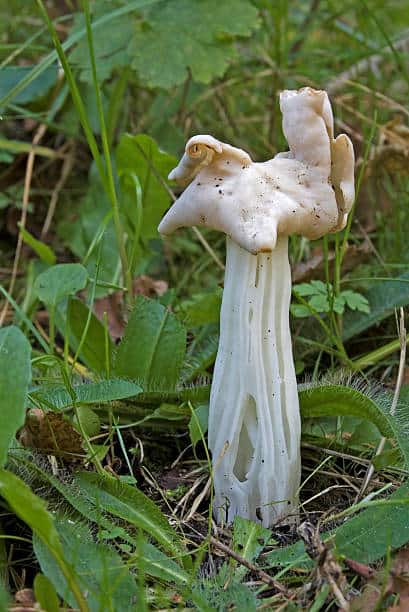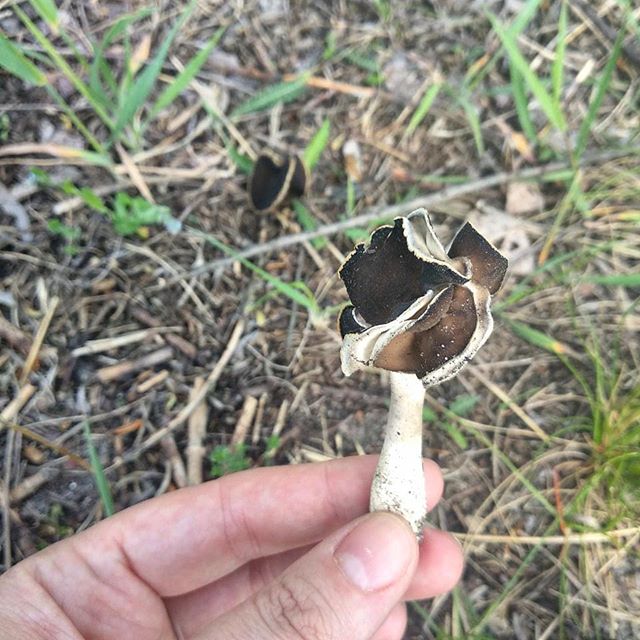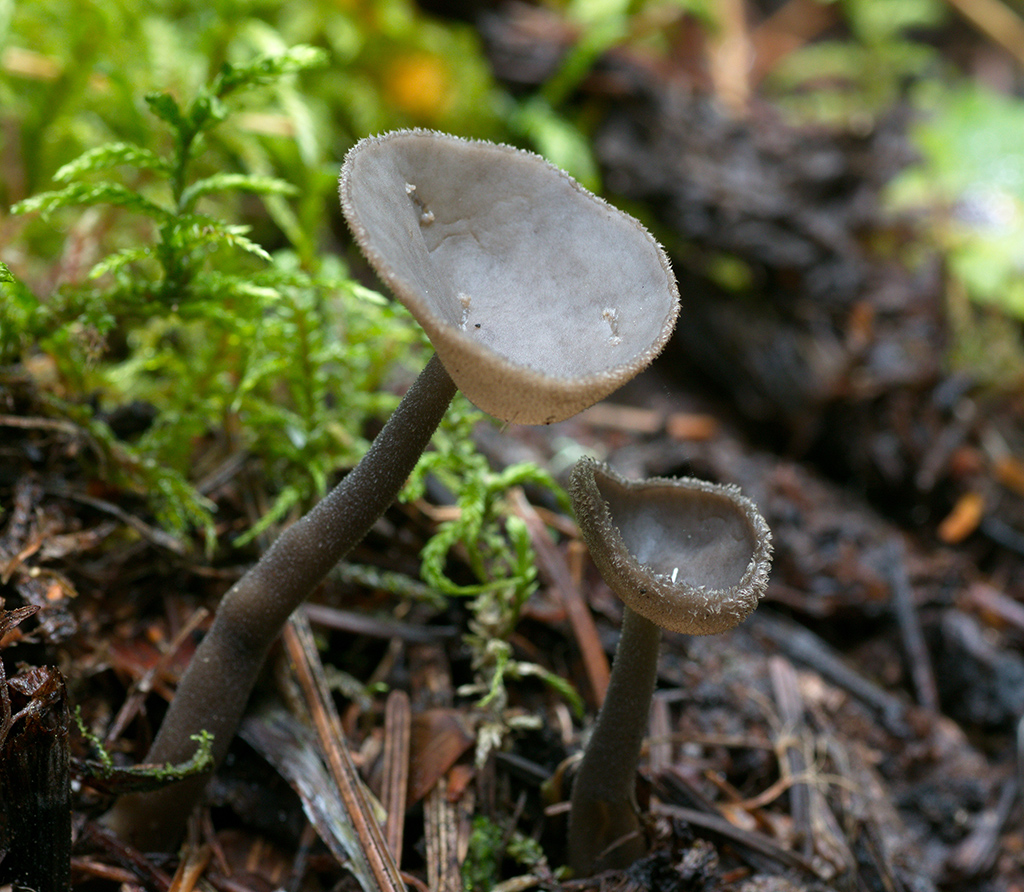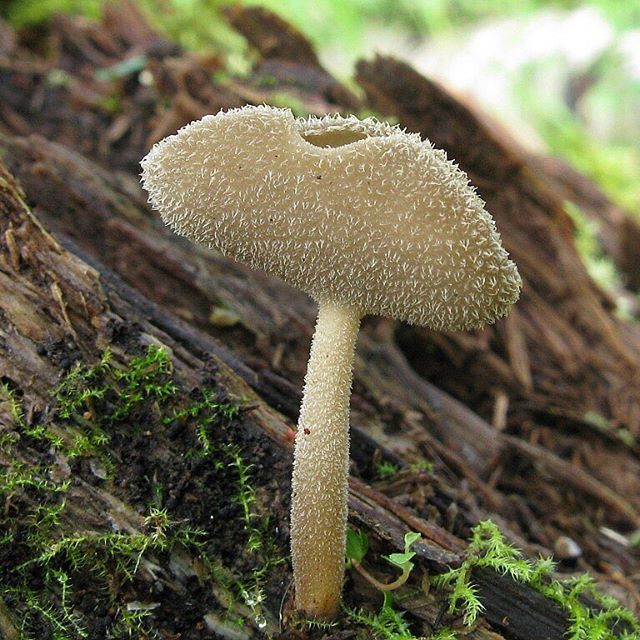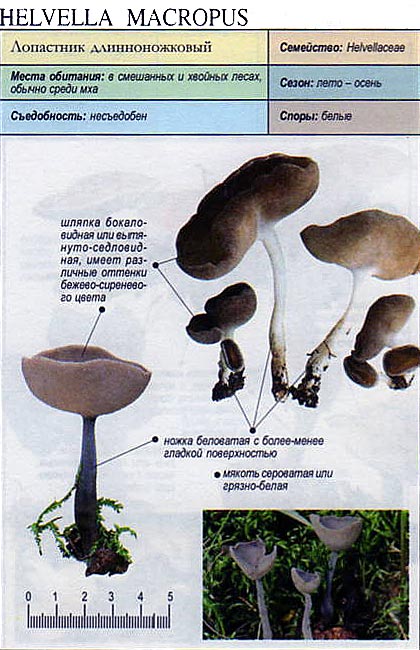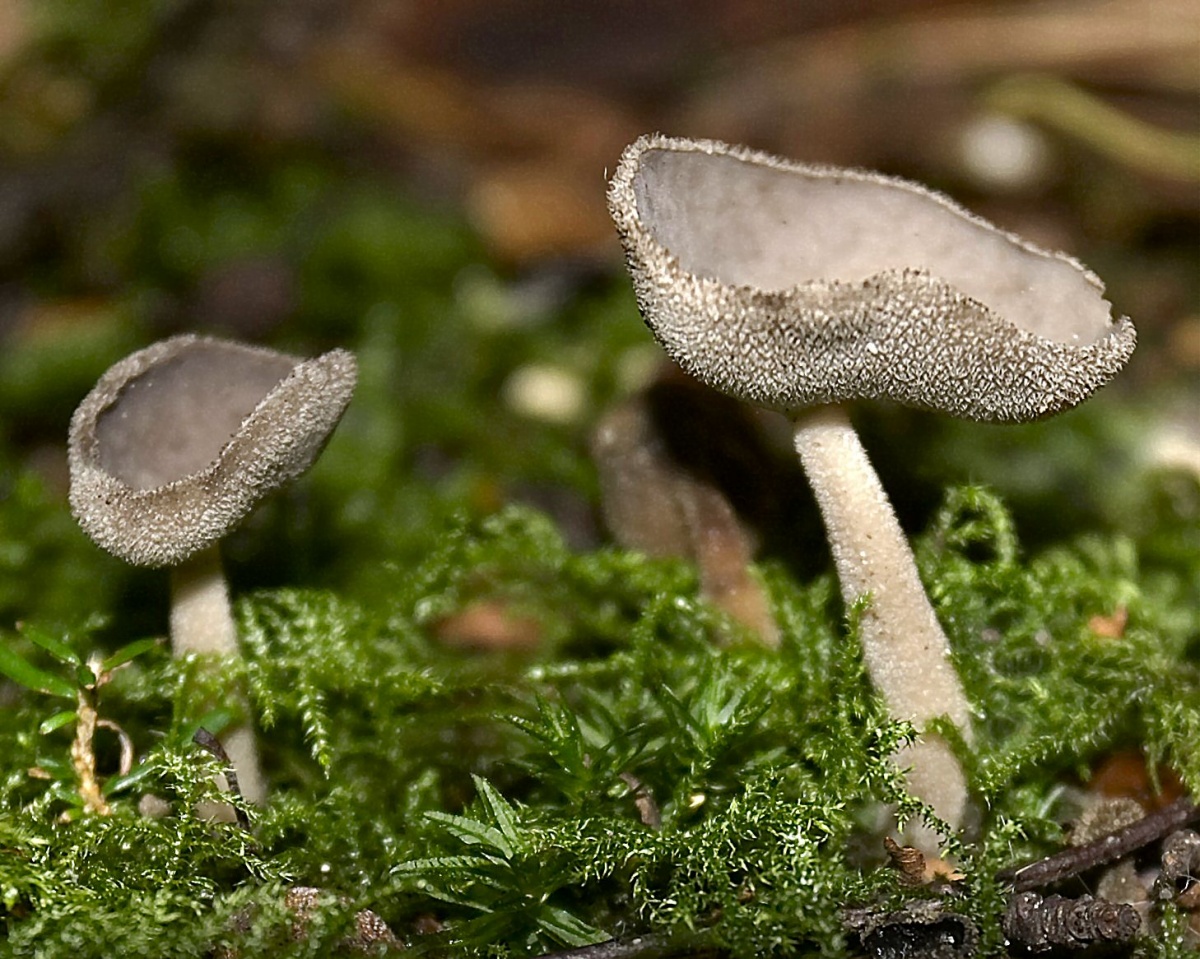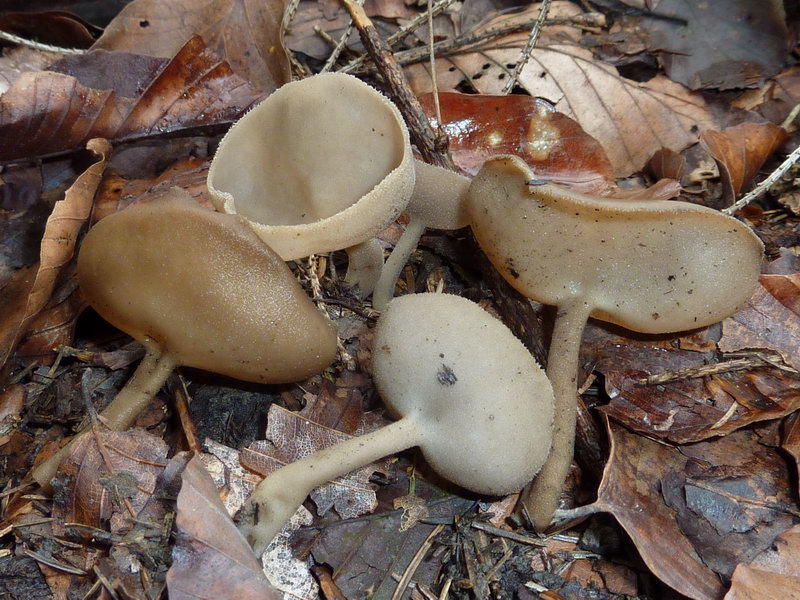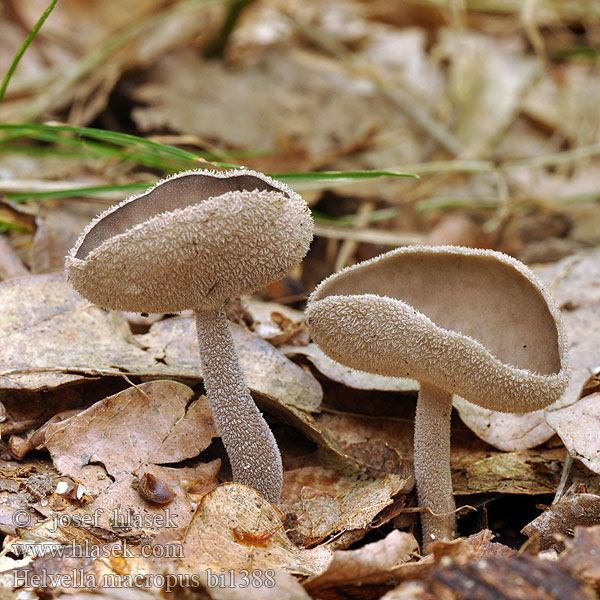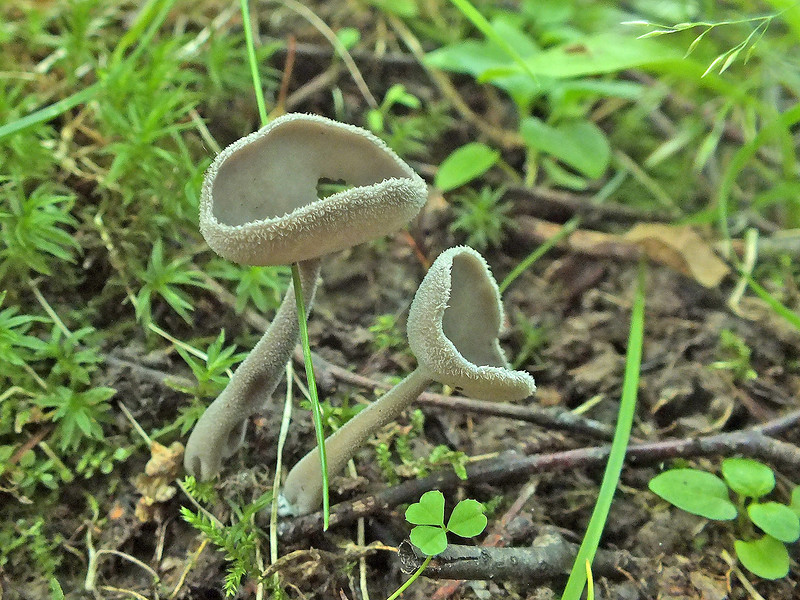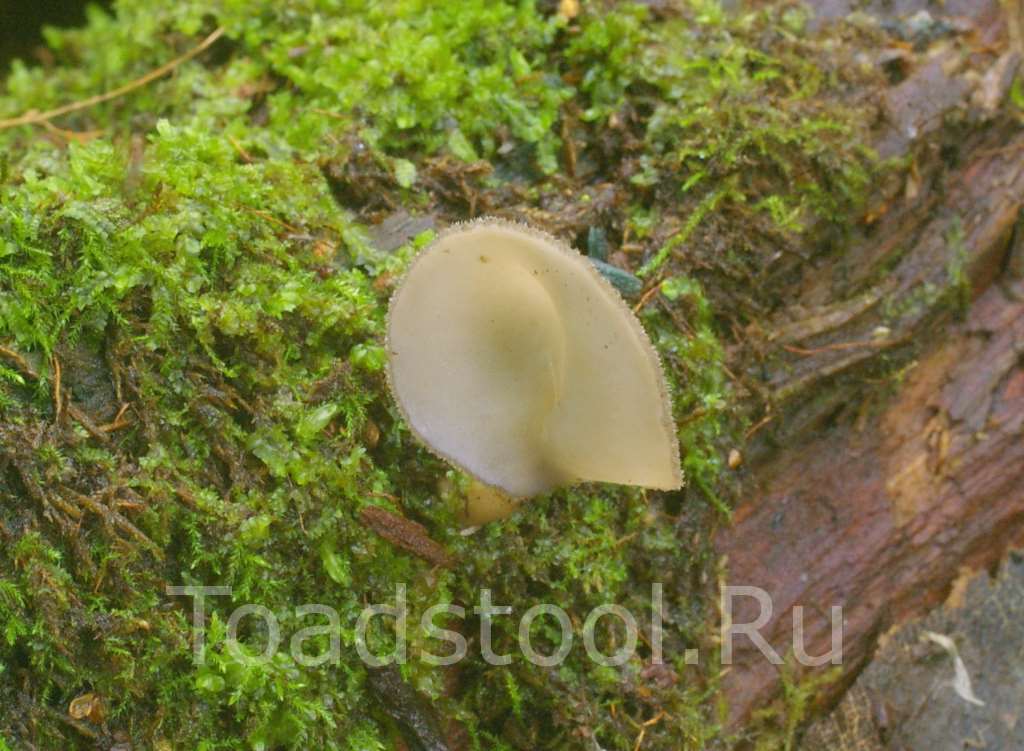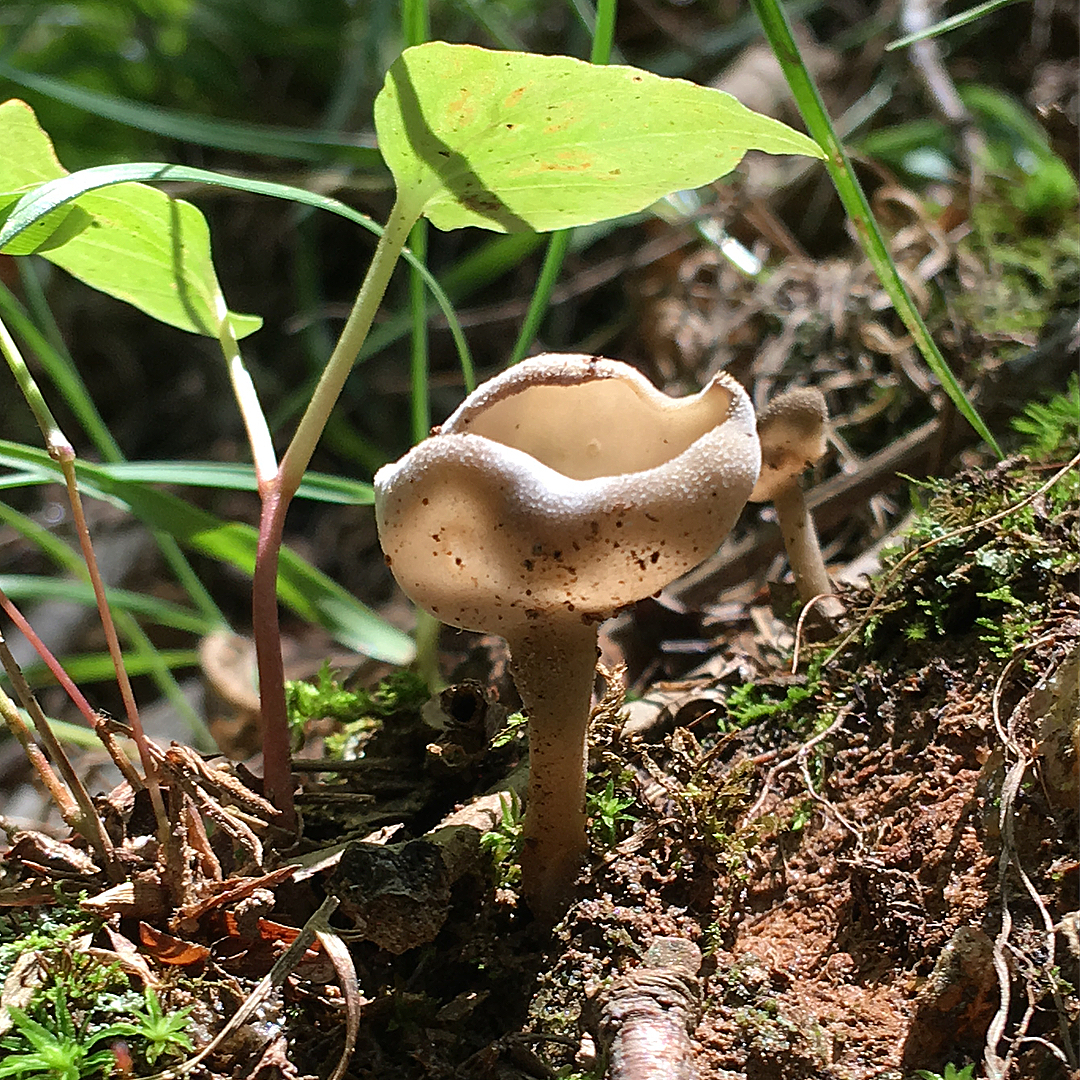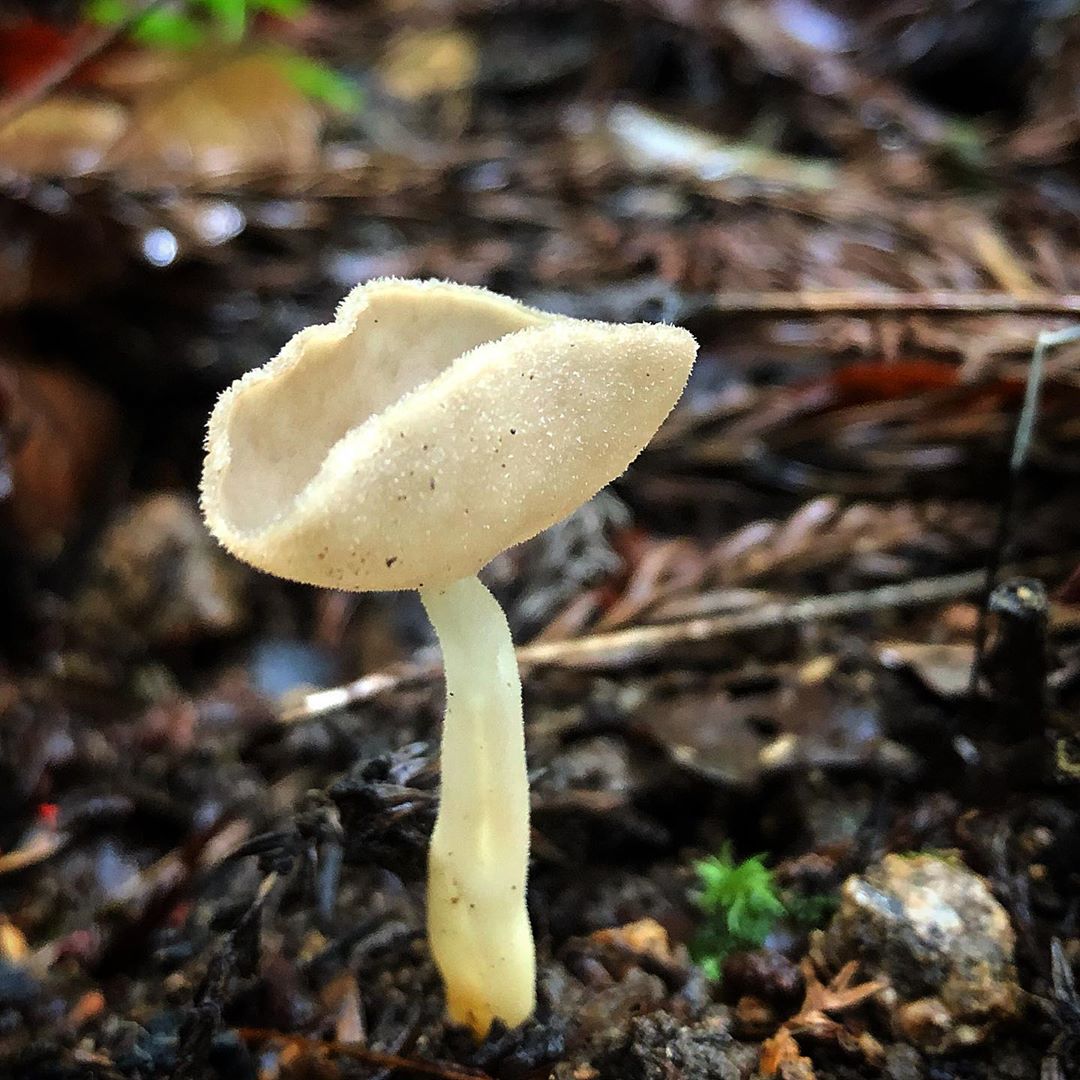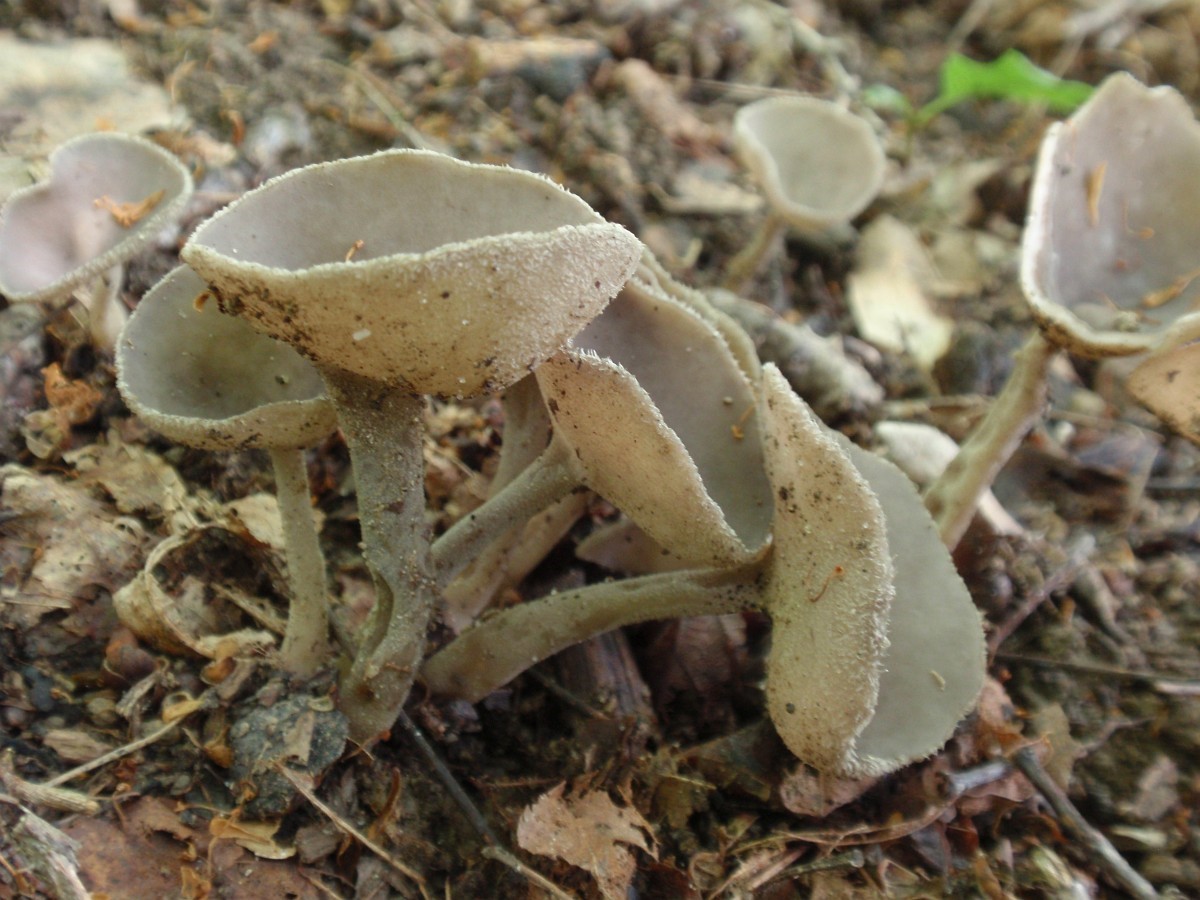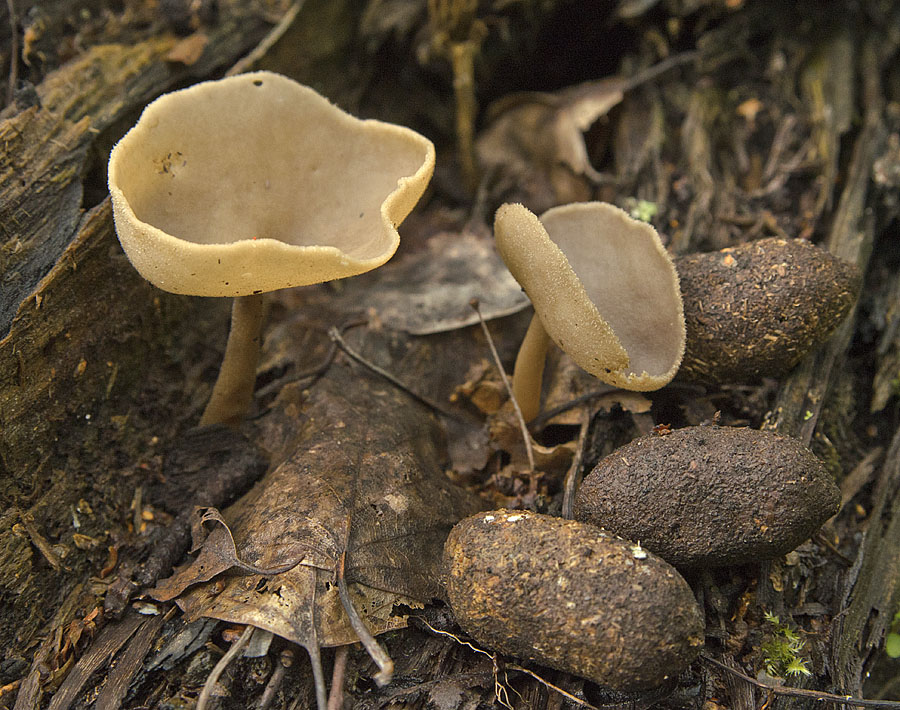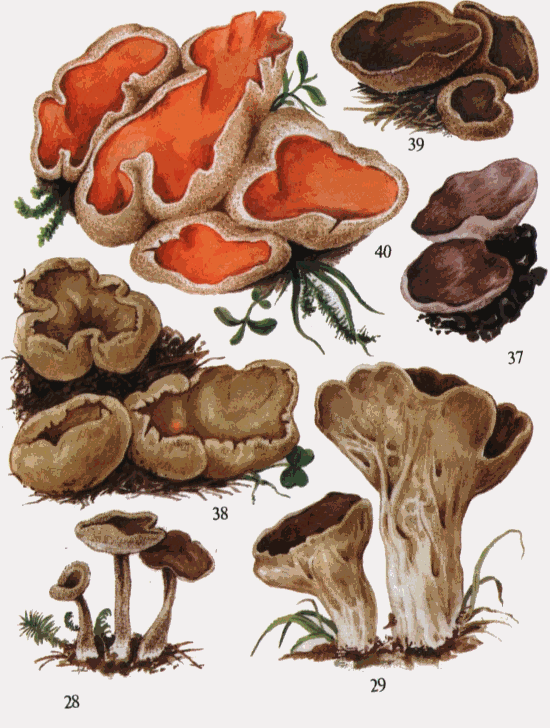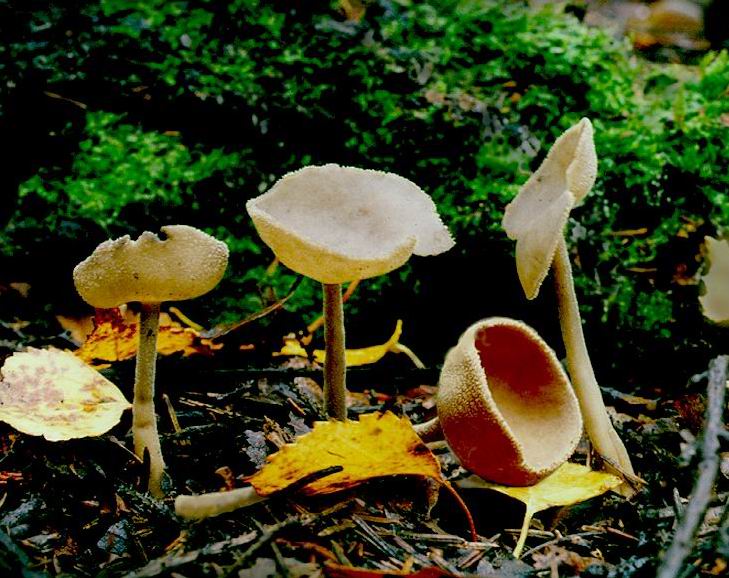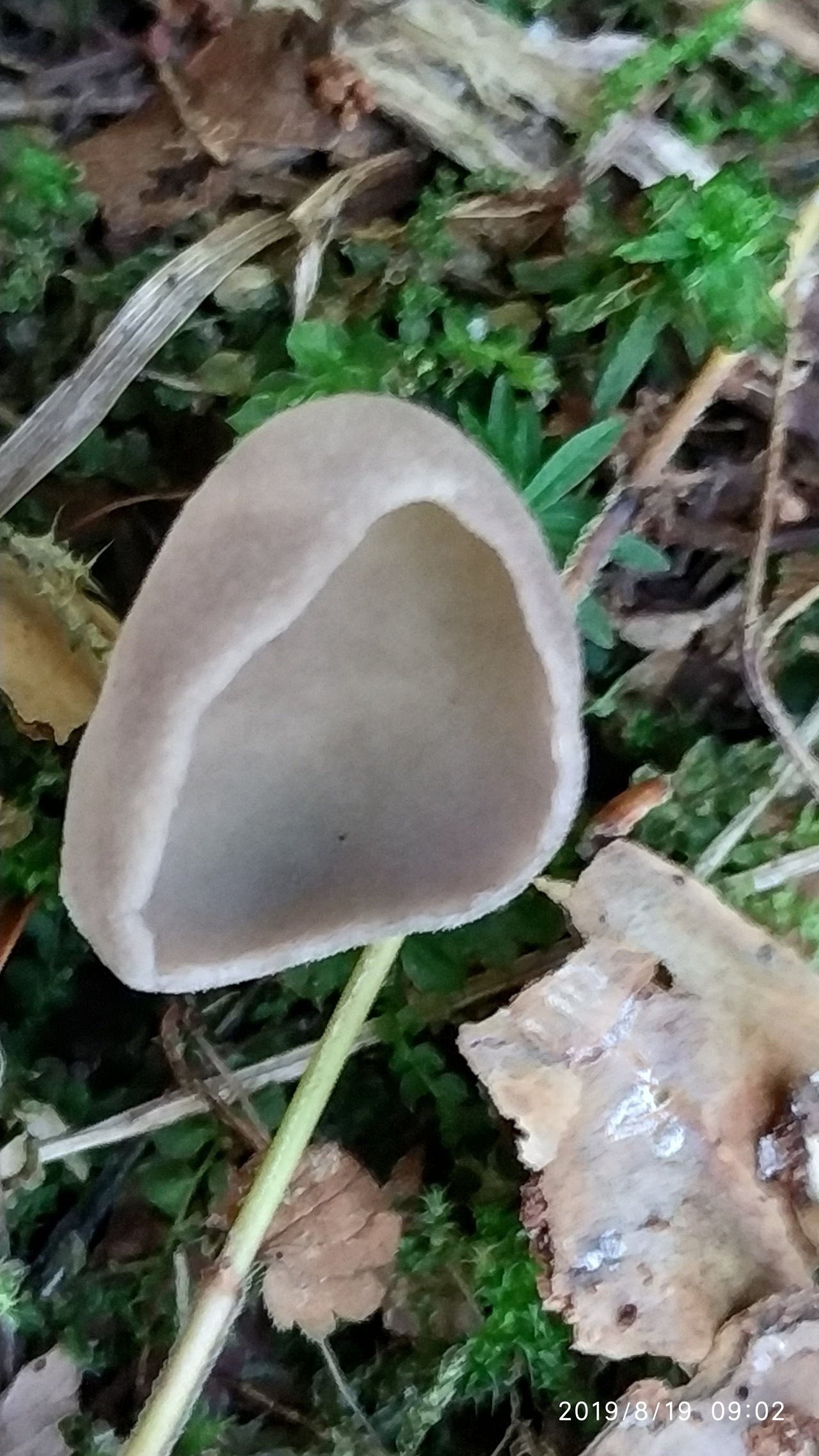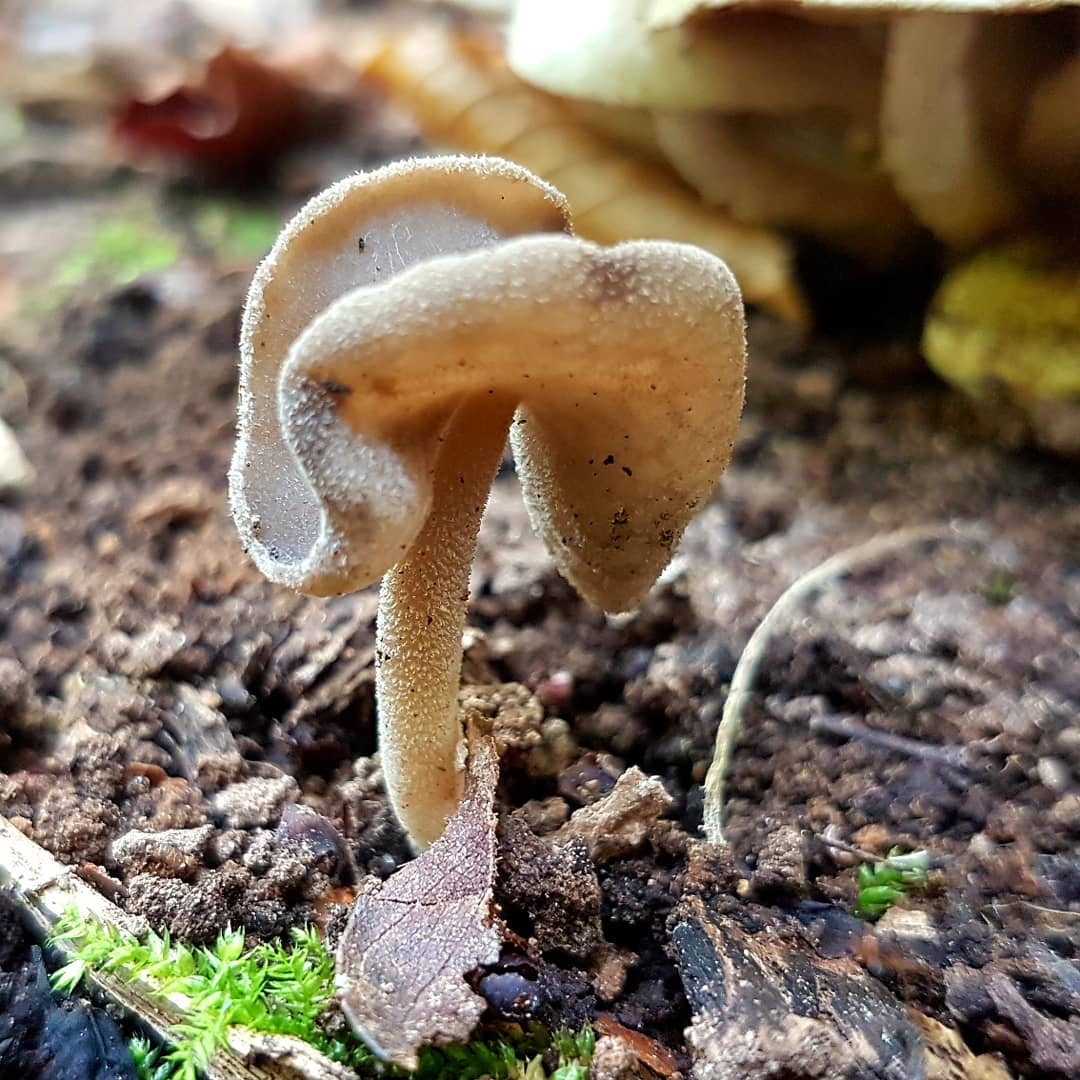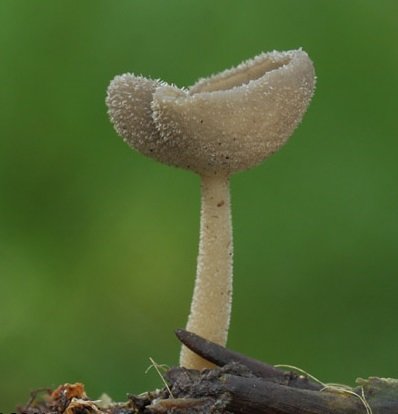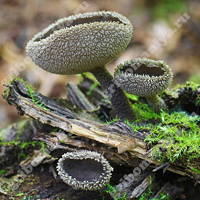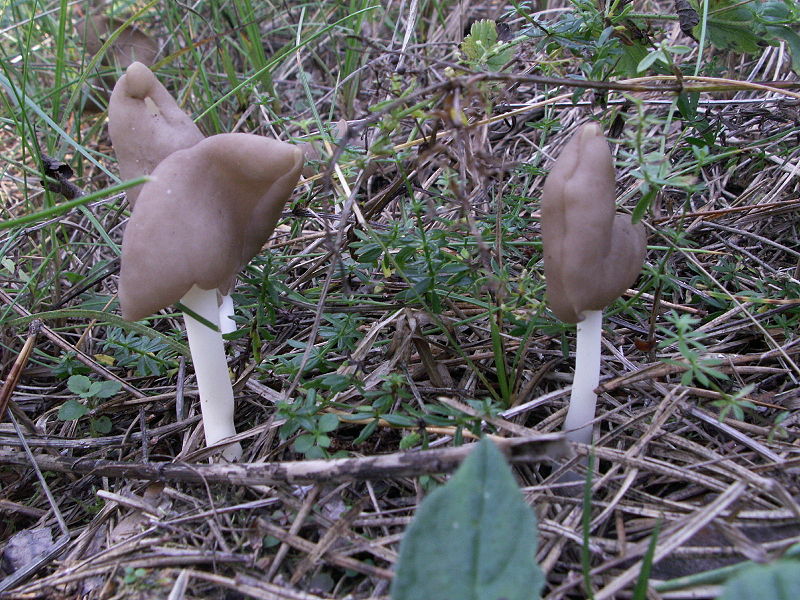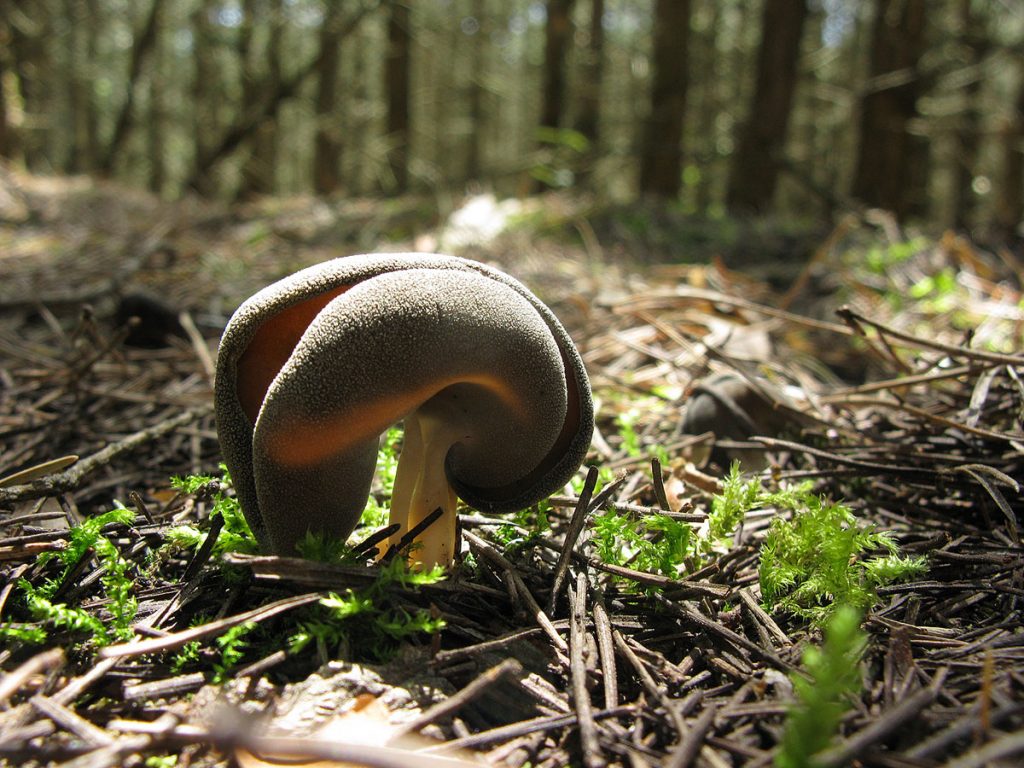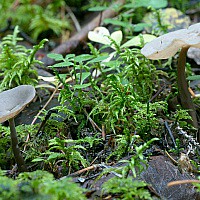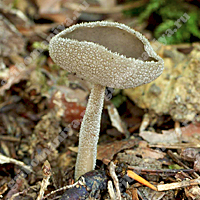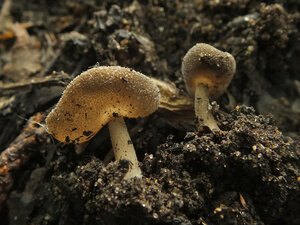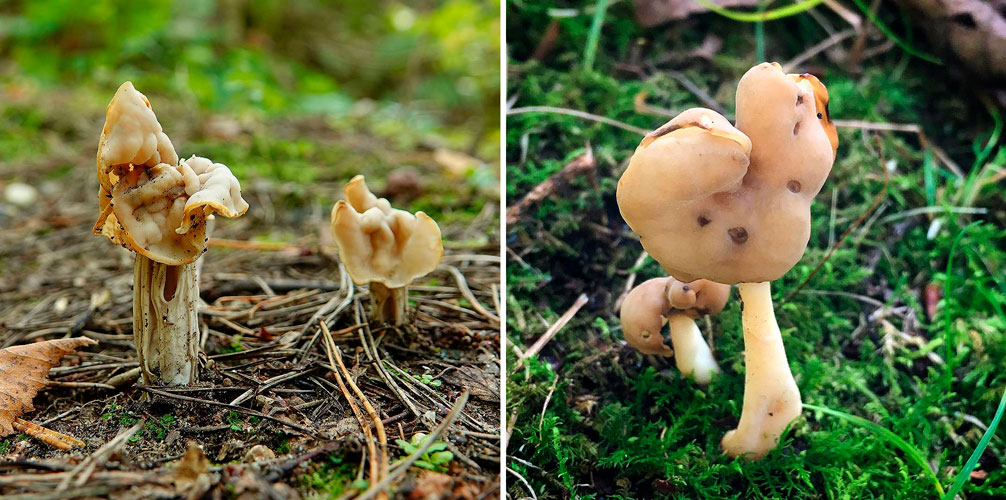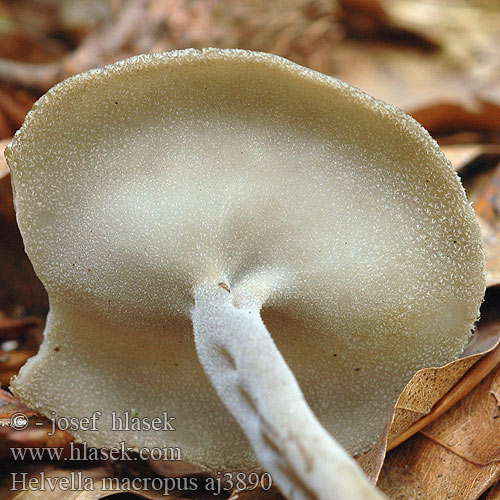Description of long-legged lobe
The diameter of the pseudo-hat is 2-6 centimeters. Its shape is saddle or goblet, flattened on the sides. The inside of the hat is smooth, light, white-yellow in color. And the outside color comes to gray and purple, while the surface is pimply. The flesh of the cap is watery, thin, gray in color. The pulp does not have a pronounced taste and smell.
The color of the leg is grayish, close to the inner color of the cap. Its length is 3-6 centimeters, and its diameter is 0.5 centimeters. The surface of the leg is smooth or slightly bumpy. The top is often tapering.
On the outer, bumpy, dark side of the cap, there is a spore-bearing layer. Spore white powder.

Distribution sites of long-legged blades
Long-legged lobules bear fruit from August to the end of September. They can live in various types of forests.
They prefer damp places. Most often, these mushrooms appear in groups.
Distinctive features of long-legged lobe
This mushroom is characterized by a striking feature - a leg, due to which it differs from a number of bowl-shaped lobes. However, the long-legged shovel has similarities with some less common species, from which it can only be distinguished under a microscope.

Evaluation of the edibility of long-legged lobe
This is an inedible type of mushroom with no culinary value.
Other paddles
Curly Looper is a conditionally edible representative of the family. The hat is two- or four-bladed, folded, with curly edges, which is where the name comes from. The edges hang down and grow to the stem only in some places. The color of the leg varies from beige to pale ocher. The leg is slightly curved, short, swollen at the base. The leg is hollow inside. The color of the leg is white or gray. The pulp is very brittle and thin, with a pleasant mushroom smell.
This is a rather rare species. Curly lobe grows in coniferous and deciduous forests. Sometimes these mushrooms come across in small groups. Fruiting occurs from spring to autumn.

Elastic lobe is a conditionally edible mushroom. Its cap has a complex saddle shape. Its diameter reaches 6 centimeters. The color of the cap is brown or beige-brown. The pulp is brittle, thin, light. The knife is thin and high. It is hollow inside. The color of the leg is white, its surface is smooth.
Elastic lobes grow in mixed and deciduous forests. Fruiting from August to September. You can find them in damp places. Under good conditions they bear fruit in numerous groups.

Edible mushrooms, berries, herbs
Curly loafer (helvella crispa)
From May to early June and from mid-August to October in deciduous, coniferous and mixed forests, near bushes, along paths and roads, you can meet a mushroom from the Helwell family - curly lobster (curly helvella). The fungus has an irregularly shaped fruiting body with a notched ribbed stem. Grows in groups, rarely singly. preferring the grass cover.
The hat is from 1.5 to 4.5 cm in diameter, two- or four-bladed, usually curved. The edges are wavy-curly, free, adherent in places. The color is light yellow or ocher.
The leg is pitted-furrowed, fusiform, slightly widened towards the base, light white, hollow inside.
The pulp is thin, brittle, whitish, practically odorless.
The mushroom is edible and has low taste and organoleptic qualities. Edible after pre-cooking for at least 12 minutes. In addition to cooking, you can also dry it.
Photos of curly lobe (helvella crispa)
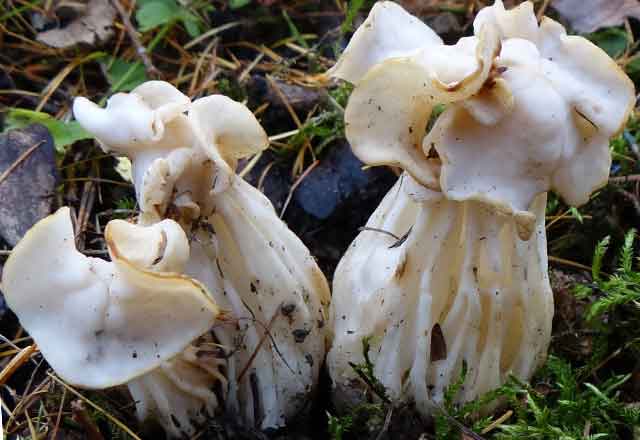


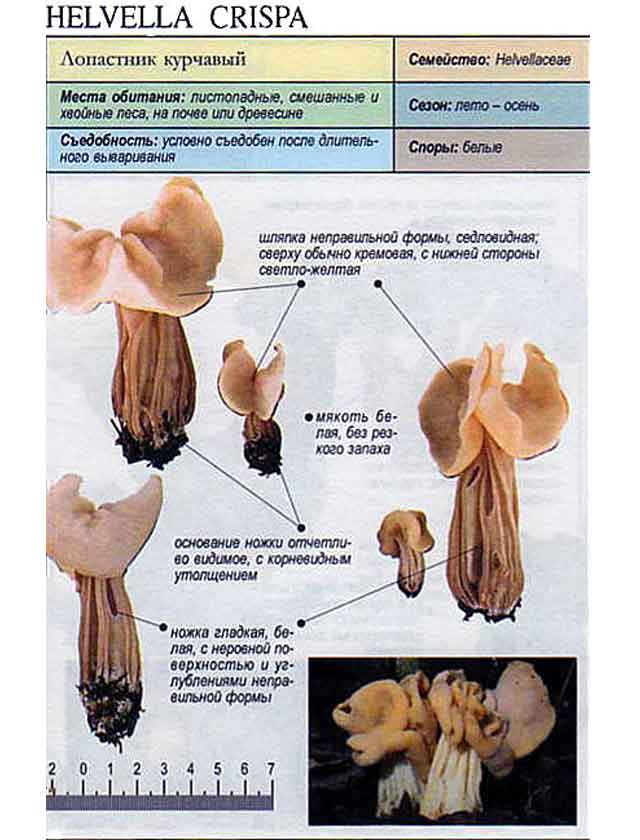
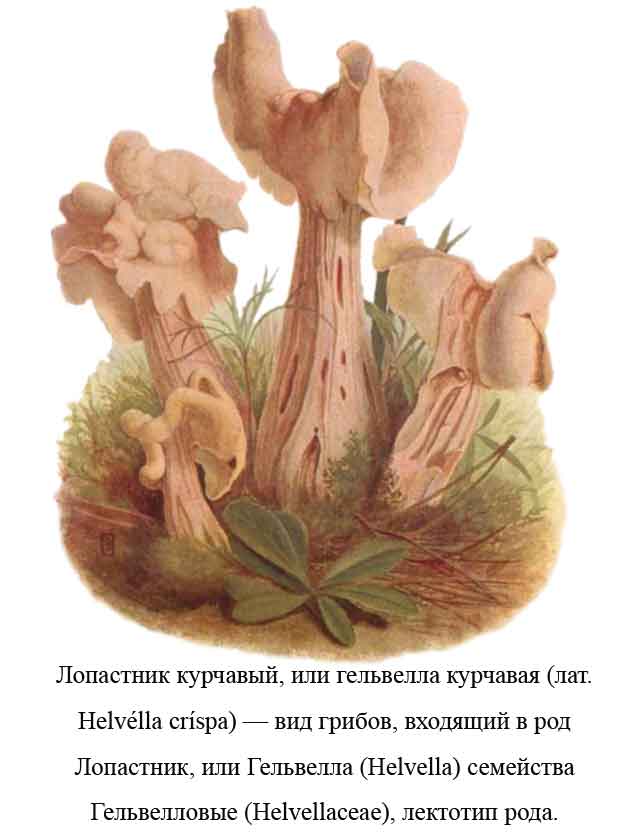
Video about how and in what conditions curly lobes grow, how these mushrooms look in natural conditions
The collected impressive volume of Ivan-tea raw materials or limited free time (sometimes all together) do not allow making Koporye tea by hand using traditional technology. Modern means come to our aid, one of which is a simple electric meat grinder. Tea made in this way is obtained in granular form. (more)
Already in April, delicious gourmet spring mushrooms - morels, represented by three main types: real morel, conical morel, morel cap - begin to grow en masse. Giant and ordinary lines can often be found next to morels. For lovers of exotic dishes, the spring forest also offers the most beautiful sarkoscifs, miniature strobiliurus, and a variety of saucers. In May, the species composition increases significantly: various horned beetles, dung beetles, tinder fungi, champignons, raincoats, May ryadovki, entolomy, pecicia, and spring mushrooms are added.
Edible mushrooms of an unusual shape, found in the European part of Russia, Belarus, Ukraine, Kazakhstan, Germany, have been added to the catalog:
Black loafer: photo and description
| Name: | Black lobe |
| Latin name: | Helvella atra |
| Type of: | Inedible |
| Specifications: |
|
| Systematics: |
|
Black lobster (Helvella atra) is a mushroom with an original appearance, belonging to the Helwell family, from the Lobster genus. Other scientific name: Black leptopodia.
Black lobe is extremely rare in our forests.
What does a black paddle look like
Only the fruiting bodies that have appeared have the appearance of a kind of saddle on a pedicle or a fractured disc. The hat has a rounded centerline fold, whose outer corners are noticeably raised above the horizontal. The halves of the cap are strongly lowered down almost in a straight line or slightly rounded inward, the edge is often accreted to the stem. As it develops, the surface bends in bizarre waves, changes to shapeless lumpy. The edges can be noticeably turned outward, exposing the inner surface, or, conversely, hug the leg with a kind of cape.
The surface is matt, dry, slightly velvety. Gray to dark gray with brown or bluish tinge and shapeless blue and black spots. The color may darken to brownish black. Inner surface, hymenium, smooth or slightly wrinkled, with pronounced bristles, brownish or gray in color. The pulp is brittle, loose, tasteless. Its color is transparent gray, like wax. The diameter can be from 0.8 to 3.2 cm. The spore powder is white.
The leg is cylindrical, expanding towards the root. Dry, pubescent in the upper part, with longitudinal stripes. The color is uneven, noticeably lighter at the base. Color from beige, gray-cream to dirty bluish and ocher-black. The length is from 2.5 to 5.5 cm, the diameter is 0.4-1.2 cm.
Legs are often crooked, with shapeless dents
Where do black blades grow
Distributed in Japan and China, where it was first found and described. Then it was discovered on the American continent and in other regions of Eurasia. It is extremely rare in Russia, and it is a great success to see it.
Prefers deciduous forests, birch forests. Sometimes its colonies are found in pine forests, spruce forests. It grows in large and small groups, with loosely located individual mushrooms. Loves dry places, sandy soils, grassy meadows in gardens and parks. The mycelium bears fruit from June to October.
The black lobe feels great on rocky areas.
Is it possible to eat black blades
Black lobster is classified as an inedible mushroom due to its low nutritional value. There is no scientific data on its toxicity.It can be confused with other members of the Helwell species.
Lobules are pitched. Inedible. It has a larger size, fleshy thick leg.
The legs of these fruiting bodies have a characteristic cellular shape.
Lobule petsytsevidny. Inedible. It differs in a noticeably upward-curled edge of the cap.
The flesh of the cap is so thin that it shines through
White-legged lobe. Inedible, toxic. It has a pure white or yellowish stem, a light hymenium coloration and a blue-black cap.
Conclusion
Black lobster is an interesting rare mushroom from the Helwell family, a fairly close relative of pets. Inedible, according to some reports, toxic. It has an extremely low nutritional value, so you shouldn't risk your health. In Russia, several colonies of this fungus have been found in the region of Novosibirsk. Its habitat is China, Europe, North and South America. Grows in deciduous, sometimes coniferous forests from early June to mid-October.
Long-legged lobe: what it looks like, where it grows, photo
| Name: | Long-legged lobe |
| Latin name: | Helvella macropus |
| Type of: | Inedible |
| Synonyms: | Helwella long-legged, Macropodia long-legged |
| Specifications: | |
| Systematics: |
|
Long-legged lobe is an unusual mushroom of the Helwell genus. Having met his family in the forest, you might think that in the middle of the clearing, someone has placed a service. This is because the top of the mushroom resembles a glass in which morning dew collects. This species is also called macropodia and long-legged Helvella, and in the official reference books of mycologists it can be found as Helvella macropus.
How long-legged lobes look like
The fruiting body of this species consists of a pseudo cap and an elongated stem. The diameter of the upper part reaches 2-6 cm. Its shape is irregular, round-disc-shaped with the edges turned upwards, which in appearance resembles a glass. However, there are specimens similar to a saddle, since their pseudo-hat is flattened on both sides. Inside, the surface is smooth and light in color, and on the outside it is fuzzy-pimpled, and its color is darker, ranging from brown to purple. Due to the structure of the upper part, water is often collected in it.
The flesh of the long-legged lobe is watery thin. It crumbles easily even with little physical impact. It has a gray tint at the fracture, which does not change upon contact with air. There is no pronounced mushroom smell.
The leg reaches a length of 3-6 cm, depending on the age of the mushroom. The bottom part is 0.5 cm thick. Its shade is light gray, like the inside of a pseudo hat. The surface can be smooth or slightly bumpy. At the bottom, the leg is slightly thickened. When cut, you can see the cavity inside.
The hymenophore is located on the outside of the upper part. The spores are white in color, their size is 18 - 25 × 10.3 - 12.2 µm. They are elliptical or spindle-shaped.
Often, the leg of this lobule narrows in the upper part.
The long-legged lobe has a pronounced characteristic feature that sets it apart from other bowl-shaped relatives - an elongated narrow stem. However, it can be distinguished from less common representatives of this genus only by microscopic signs in laboratory conditions.
Where long-legged lobes grow
Long-legged lobe belongs to the category of saprotrophs, therefore, certain favorable conditions are necessary for its growth. For nutrition, he needs a substrate based on organic compounds, which are formed as a result of the decomposition of plant remains.Therefore, most often the long-legged lobe grows on half-rotten stumps and tree trunks, which are in the last stage of decomposition. It can also grow directly on soil rich in organic matter, in grass and moss.
This species grows in families of 4-10 specimens, but in exceptional cases it can be found singly.
This species can be found in mixed and deciduous forests in the central part of Russia and European countries. The representative belongs to the category of rare mushrooms.
The fruiting period of long-legged lobe begins in mid-summer and lasts until early October. Its duration depends on weather conditions.
Is it possible to eat long-legged lobes
Long-legged lobe is considered inedible. You cannot eat it even after preliminary heat treatment. Although this fact remains questionable, since special studies in this direction have not been carried out.
But, judging by the appearance and prevalence of long-legged lobe, it is unlikely that a mushroom picker (even a beginner) will want to collect and harvest it.
Conclusion
The long-legged lobe is a bright representative of the Helwell genus. It is considered little known among lovers of quiet hunting, as it belongs to the category of inedible. But it enjoys increased interest among mycologists.
This mushroom can rarely be found in the forest, but if you managed to find it on occasion, you should not pluck it out of idle interest. It is better to admire him from the outside and allow the disputes to fully mature, which will allow him to leave behind offspring.

